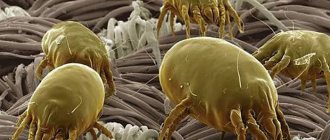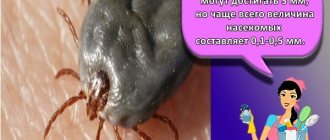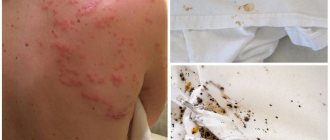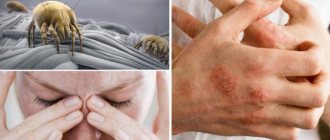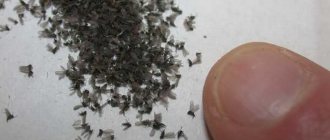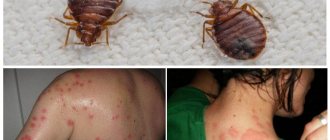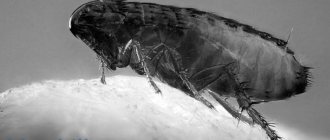Many housewives are interested in the question: where does dust come from? Even the constant presence of cleanliness in the home will not get rid of it.
In any home there are textile items, books and newspapers, and other paper products that can cause dust particles to appear.
And to this add ventilation and air conditioning of the apartment. Residents come and go, bringing with them dust from outside.
This is the result: a thin layer of disorder appears on any surface. But we are interested in dust mites, which can live in the thickness of this very dust.
Dust mites under a microscope
What are they and what harm do they cause to humans, and even more so how to deal with them if parasites suddenly appear.
Ideal home environment
Dust mites mainly accumulate in places such as:
- A bag for collecting dust in a vacuum cleaner.
- Bed, namely mattresses, pillows, blankets, bedding.
- Upholstery of sofas, armchairs.
- Carpets, rugs.
- Cloth.
- Stuffed Toys.
- Human hair and skin.
- Pet hair and much more.
Microscopic arthropods feed on the epidermis, namely dead skin particles. Therefore, a person’s home is an ideal habitat, because during the day several tens of millions of skin flakes are exfoliated from each of us.
If you do the math, one person sheds 2 kg of dead cells in a year. Ticks feed on these cells. But it’s not just constant food that ticks need to survive.
In addition, for a prosperous life they need several conditions:
- room temperature 18-25 degrees;
- humidity 70-80%;
- darkness.
This is why insects love to settle in a person’s bed.
70% of the mites in the apartment are collected in the bed, mattress and bedding . And in the absence of any treatment, after three years, a mattress can turn into a den of dust mites and consist of 10% mites and their excrement.
You can learn more about where dust mites come from and how to deal with them here.
Why are ticks dangerous?
Allergic reactions
Dust mites, or rather their feces and the shells of dead insects, contain digestive enzymes (harmful proteins) that destroy human skin cells and cause severe allergies in some people. The antigens of these arachnid representatives can cause the development of atopic dermatitis, bronchial asthma, conjunctivitis and allergic rhinitis.
People with low immunity, city residents, and children are most prone to allergic reactions. Symptoms most often appear at night or during cleaning, as well as upon contact with old cotton items.
Dust mite allergy symptoms:
- Persistent or recurrent runny nose;
- Constant or periodic suffocating cough;
- Rapid breathing;
- Redness and itching of the skin;
- Tearfulness and redness of the cornea.
Important! At the first sign of an allergy, you should contact your family doctor. Self-treatment can only temporarily relieve symptoms or aggravate the allergy sufferer’s condition.
At what temperature do they die and under what circumstances will they be unable to live?
Regular wet cleaning of premises, washing carpets and blankets, changing bedding and other methods of cleaning the home from organic compounds will deprive ticks of food, which means they will die.
At what temperature do ticks die? Reducing the temperature to 10 degrees or lower and lowering the air humidity to 40% will significantly reduce the activity of parasites. If these conditions persist for two weeks, the dust mites will die. They also die at temperatures above 60 degrees.
Dust mites cannot tolerate washing and ironing , so to get rid of them you need to wash your clothes and linen on time.
Is it possible to get rid of it yourself or is it better to turn to disinfectants?
Find out how to get rid of insects living in dust. It is not possible to completely get rid of dust mites on your own, since these arthropods easily penetrate through cracks or through clothing. At home, it is only possible to significantly reduce the tick population. To do this, it is necessary to carry out several activities:
- Get rid of old pillows, carpets, mattresses, soft toys and other dust carriers.
You can replace down pillows and blankets with pillows and blankets made of artificial hypoallergenic materials, but not synthetic padding. If it is impossible to get rid of the above items, then they must be washed using specially selected anti-mite additives or at a water temperature of 65 degrees. - Carry out wet cleaning of the home at least once a day.
- Use washing vacuum cleaners, adding anti-mite drugs to the solution.
- Buy air purifiers with ultraviolet light. Ultraviolet lamps can destroy arachnids within two hours.
- Don't let pets sleep in your bed. Pet fur harbors ticks, which can travel long distances.
These methods will help reduce the population of dust mites, but will not get rid of them completely, so it is better to turn to disinfectants to treat the room.
If your health condition worsens, it is necessary to diagnose the apartment as quickly as possible . If experts have detected the presence of arachnids in the house, then the apartment should be immediately disinfected.
Dust, dust mites and their allergens. Prevention and protection
Dust and dust mites are present almost everywhere and always. They can only be destroyed in “clean room” conditions in semiconductor production. We have to put up with this and live in the assumption that all we can do is reduce their number. It is believed that if the concentration of mites is <100 mites per gram of dust, most people do not develop an allergy. After I had to sneeze nonstop for a couple of minutes, I had accumulated enough anger to consider what the dust in the apartment was and what and who lived in this dust. And now we’ve found time to introduce Habr’s readers to “our little friends.” The note discusses some features of the biology of the ubiquitous domestic parasite and methods for its control. What you can safely give to your wife to read under the cut, %username%!
The article does not correspond to the topic of the hub and the article contains more advertising than benefit
It is precisely such formulations that are the absolutely predominant reason for the disadvantages of my articles.
I think this one will be no exception. So, I’ll make excuses in advance for frequent mentions of my own articles. I can’t help the fact that it’s not shameful to self-quote what I write, and most importantly, it’s more useful for an interested reader than quoting Russian Wikipedia (regarding chemistry, by the way, it’s stupid). A la guerre comme à la guerre, friends. Why is dust in the house harmful? If you ask this question to the first person you meet on the street, you will most likely hear that dust leads to allergies/runny nose, or that dust is an ideal environment for the proliferation of viruses and bacteria. If someone asked me such a question, I would answer “ dust is the decay products of radon and dust mites
.” I will definitely write about radon dust in the channel (as part of the continuation of the “Circle of a Young Radiophobe” series). And let’s talk about mites now, “after sneezing again” (sinful, I don’t have the strength to exclusively control dust, and as you know, “if you can’t do it, go teach it”).
So, our little ubiquitous neighbors in houses and apartments with a suitable microclimate. The dust mite, unlike my favorite, the ixodid tick (which carries borreliosis), belongs to the family Pyroglyphidae. The dust mite is much smaller than the forest mite - 0.2...0.3 mm and has a barely noticeable translucent body. A distinctive feature of the dust mite is the “striped” morphology of the chitinous cover.
These mites feed on dead scales of the human epidermis (flaky skin). If we assume that about 70-150 mg of skin flakes are shed from the body of a healthy person every day, then this amount of food is enough to feed the European dust mite population for several months.
Another important element in the diet of ticks is mold. For example, the American dust mite Dermatophagoides farinae (European D. pteronyssinus has a similar taste) eats the mushrooms Alternaria alternata (Alternaria late blight) and Wallemia sebi
.
The last fungus is interesting because it was found on human hair and on various tissues. This mold can grow slowly even in the absence of nutrients and form small reddish-brown colonies. And also W. sebi. can regulate its morphology and physiology to adapt to different environmental conditions (drought) and withstand osmotic stress. I have already written in detail about the mycotoxins that Alternaria produces, but I’ll say a few words about the mycotoxins of Wallemia now. The main ones are the tricyclic dihydroxysesquiterpenes valleminol, valleminone, vallimidione plus the azasteroid UCA1064-B. The most toxic among the metabolites is vallimidione. By the way, expecting the main question from the reader, I will answer it right away. Dust mites do NOT eat the “black mold” Stachybotrys chartarum, nor do they eat the common golden mold Penicillium chrysogenum and Aspergillus versicolor. Those. mycotoxins produced by these fungi (citrinin and sterigmatocystin
, a carcinogenic precursor of aflatoxin) can be ignored.
Returning to Wallemia mushrooms. They may not produce mycotoxins; it all depends on environmental conditions. An interesting distinctive feature of this mold is that toxins begin to be actively produced when the NaCl salt concentration increases (and the mite can withstand concentrations of up to 28% NaCl or 17% MgCl2). The most interesting thing is that Wallemia most often lives on dried and salted fish (especially in temperate climates). So, if suspicious red-brown spots are found on your favorite “beer smelt”, throw away the “yummy”.
The second favorite product of the fungus is objects with a high sugar content (jams, preserves, maple syrup from Canada, etc.) and... condensed milk (if you see brown spots on condensed/concentrated milk, then know it is W. sebi). Mold (more precisely, “xerophilic mold”) can also affect brown rice that has been stored outdoors for a long time. There is a lot of this mold in house dust, although it was first identified by the Japanese in 1989. Since then, the fungus has often been positioned (along with dust mites) as a cause of asthma and allergies (in 20% of children from 3 to 14 years old, by the way). Wallemia is also associated with an increased risk of respiratory symptoms, exacerbation of asthma, hypersensitivity pneumonitis, rhinosinusitis, bronchitis and other respiratory infections. They link something, but do not explain the mechanism. I will risk linking everything with the effect of mycotoxins, since I have unwittingly become a public ambassador of mycotoxinology. Attention directed to secondary metabolites of Wallemia in the scientific world is presented fragmentarily.
We’re done with mold and its mycotoxins, let’s return to mites, there’s more to say here too. Most often they are considered safe and are perceived only as donors of allergens (allergies can occur if there are as few as 100 mites/g dust).
Let me remind you once again that the main source of food for mites is dead skin (dermatophyte mites). For digestion, the tick's body contains special enzymes (like peptidase), which are stored in feces and are the main activators of allergic reactions. There are opinions that the chitinous skeleton of the tick (chitinase enzyme) and the protein tropomyosin from the muscles contribute to the occurrence of allergic reactions. The size of house dust mite fecal pellets is 10–40 microns. Those. They still fall into the group of PM10 particles, but cannot penetrate into the bloodstream (this is already the prerogative of PM2.5 particles with a diameter of 2.5 microns or less). In addition to respiratory problems, dust mite infestation has been associated with atopic dermatitis and damage to the skin's epidermal barrier.
How to tell if there are mites in dust
You can indirectly estimate it as follows.
If you a) have at least small amounts of dust b) a suitable microclimate in your apartment, then you definitely have dust mites. No matter how thoroughly you clean, if even a little dust remains, these arthropods will appear in it. Due to their small size, they are quite easily transported over short distances by the wind, and indeed by air movement in general. For example, checking a dust blanket using a microscope can provide more accurate data. Even the simplest Chinese usb/wifi microscope (>100x) from aliexpress will allow you to see moving arthropods. There were people who proved to me that they could see transparent, a fraction of a millimeter, dust mites crawling on a blanket, but... But I leave these statements to the conscience of the “eyewitnesses”. Dust mite vs USB microscope
“Adult” microscopes are also suitable for identifying mites.
The best option is metallographic microscopes with illumination and the ability to observe in polarized light. But to work with them, you need skills in preparing samples for observation, because It is not always possible to see living “impurities” in dust bunnies. At foreign online auctions you can also purchase express tests that show the presence of mites (more precisely, their metabolic products - mite allergens) in dust samples. All you need to do is vacuum up the dust and then examine the sample. Look on ebay/amazon for something like this:
Testing dust using a rapid test
How to deal with dust mites
Dust mites are a nesting species of organisms.
They prefer dark, warm and humid microclimates. The main habitats are mattresses, bedding, carpets and upholstered furniture. Typically, mites, along with dust, are found on the floor or other surfaces in relative peace. They do their job - eat. But as soon as something disturbs them and raises the air (a person walks and raises dust, a pet runs and raises dust, etc.) - they begin to pose a threat. Dust mites have a considerable size (as I wrote, the lower limit is PM10), but it still takes about 20-120 minutes for them to settle from the air back to the floor. In principle, we can say that the problem of dust mites did not exist until textile blankets and mattresses appeared, although dust has always existed. A little biology to know your enemy by sight. The American dust mite at 24°C and 75% relative humidity goes through the life cycle from egg to adult in 35.6 days. Females lay an average of 66 eggs and live an average of 100.4 days (about 63 days after laying eggs). Our native European dust mite completes its development cycle at 24°C and 75% relative humidity in 34 days. Females lay 68 eggs, and mated females live an average of 31.2 days (about 1.8 days after they stop laying eggs). Dust mite development rates, fecundity (number of eggs laid), and lifespan are highly dependent on temperature, humidity, and food availability. These arthropods are very sensitive to microclimate.
So, what should you do to minimize the risk of problems from dust mites? The simplest thing is to dry the bed linen in a “hot dryer”. Warming up for an hour will kill 99% of the ticks in it.
In defense of dust mites. Dust mites also do some useful work. For example, they restore the original microstructure of cotton fibers (bedspreads/blankets); microfibers are deformed upon contact with bare skin.
The eggs that dust mites lay in fabrics are resistant to freezing (withstand −70 ° C for 30 minutes), but are sensitive to light and heat. For example, they die when the fabric is exposed to direct sunlight for 3 hours. Dry heat (60°C for 30 minutes) or steam drying will also work. By the way, adult dust mites drown in water. Dust mites cannot survive if the relative humidity in the apartment is below 45%, but at the same time, if at least 1.5-2 hours a day the humidity rises above the specified figure (for example, when cooking), then this will be enough for the mites to survive .
Cold is the enemy of dust mites. Eggs are resistant, but adults are not. Therefore, some authors recommend freezing soft toys and small objects for 24 hours at a temperature of –17°C…–20°C. If you use a refrigerator freezer, it is recommended to wash items after freezing to remove dead mites and their allergens. A method available in cold climates for killing ticks on mattresses and pillows is to leave them in the cold for a day.
The degree of mite infestation is also influenced by the properties of the tissues. Fabrics with a pore size in the range of 2-10 microns and air permeability in the range of 2-6 cm³s⁻¹cm⁻² are more resistant. The fabric must have at least 246 threads per unit width of fabric (sq. inch ~ 6.4516 sq. cm), i.e. TPI (threads per inch) ≥ 246.
Fabric density, expressed in the number of threads per inch/square centimeter, is a measure of the fineness (or coarseness, whichever is closer to you) of the fabric. This characteristic is determined by counting the number of threads that are contained in one square inch or centimeter of fabric. This characteristic is often used to assess the quality of cotton underwear. The standard TPI value for most sheets is around 150. High quality sheets are 180 or higher. What has TPI>200 is the so-called. “Percale” is a high-strength cotton fabric made from untwisted threads.
In the West, such a direction as the production of anti-mite blankets is actively developing (?).
The main purpose of such objects is to create a barrier to mite allergens (dust mite excrement) and to prevent mites from moving through the fabric (in any direction). Vapor permeability is also an important characteristic. The greatest efficiency is shown by materials that have acaricidal impregnation (or the acaricide is introduced into the polymer at the stage of thread formation). In addition to complex organics, copper oxide CuO coatings also work well. No matter how clean your home is, it is impossible to completely get rid of dust mites. However, their number can be reduced using the following methods:
— Use a dehumidifier or air conditioner to maintain humidity at 50% or lower. — It is better to use dust-proof covers for the mattress/pillows (optimally if they are made from the fabrics described above) — All blankets and bedding should be washed at least once a week in hot water at a temperature of 55-60°C — Down and/or wool it is better to replace bed linen with synthetic ones - it is better to remove the carpet in the bedroom (or replace it with a product with a very low pile), replace fabric curtains with blinds
It cannot be completely eradicated, but the amount can be kept very low by keeping indoor humidity low and using good housekeeping practices (proper cleaning conditions, washing, etc.).
By the way, about washing. As already mentioned, washing in hot water at a temperature of ≥60°C is necessary to kill dust mites and their allergens. But few people do this, washing bedding in cold or warm water. For such people, I will provide information from an interesting study. In the experiment, common dust mites (D. farinae - American, E. maynei and D. pteronyssinus - European) were immersed in water of various temperatures, with various detergents and even bleach. The arthropods were kept in the washing solution for a certain time, and then the effectiveness of this treatment was assessed. The following happened. In clean water at a temperature of 50°C, D. farinae mites died 100% after 10 minutes of washing; the method had no effect on E. maynei and D. pteronyssinus mites. But it took 5 and 12 minutes, respectively, for these mites to die, when washed in water at a temperature of 53°C. The use of surfactants and hypochlorite bleach generally had a positive effect (increased mite mortality) in relatively clean water. Soaking fabrics with mites for 4 hours in warm water with detergents led to the death of 2–35%, 14–46% and 19–50% of D. pteronyssinus, E. maynei and D. farinae mites, respectively. Those. weekly washing of bed linen with detergents and bleach in combination with pre-soaking (4+ hours) allows you to destroy the maximum amount of D. farinae, and, depending on the severity of the detergent, destroy a sufficient amount of D. pteronyssinus and E. maynei. If such recommendations are followed, there will be a certain cumulative effect that will lead to a decrease in dust mite levels over time (provided that pillow/blanket covers with anti-mite activity or special repellents/insecticides are used).
About chemical insecticides
To date, I do not know of insecticides that would be aimed specifically at dust mites. The first thing that comes to mind is benzyl benzoate, in combination with tannin, but this is a fairly old composition. Among the more interesting and modern ones, we can recall special fabric softeners, like STERIFAB. It contains propan-2-ol (alcohol), HOUR, and the main acaricidal component phenothrin (Sumithrin aka Phenothrine aka Wellcide aka Pibutin, Anvil, Duet, Anchimanaito 20S). Phenothrin is a synthetic pyrethroid and is often used in aerosol insecticides to kill fleas and ticks. The drug is relatively safe for people, but poisonous for cats and dogs (causes seizures, etc.) Another product Nyguard Plus - contains the same phenothrin, plus the phenothrin synergist N-octylbicycloheptenedicarboximide, and pyriproxyfen (Nylar aka Cyclio, aka Virbac, aka Exil Flea Free TwinSpot, aka Emax) is a juvenile hormone analogue and insect growth inhibitor. For those interested in the topic, my article provides examples of other commercial acaricides and products, some of which also have the ability to denature dust mite allergens.
About denaturators. It is not difficult to destroy adult ticks, especially if you have chemicals on hand. But dead mites and their excrement will still be present in the dust, enter the lungs and cause allergies. In order to neutralize them, substances are used that denature mite enzymes (and reduce the allergenic potential of dust). I wrote in detail about the denaturation process in a habra article (see section Remarque about protein denaturation). This is a process that leads to a change in the conformation of a protein molecule (under the influence of various destabilizing factors) and the loss of its natural properties (solubility, hydrophilicity, etc.). Examples from real life: boiling eggs (thermal denaturation), tanning leather (chemical denaturation). Denaturation of mite allergens is approximately the same as tanning leather; it is not surprising that the same “tanning” substance, tannin, is even used for this purpose. Mite allergens are bound by the phenolic groups of tannin, polymerize and become more hydrophobic. A 3% tannin solution denatures group I dust allergens, but is somewhat less effective against group II allergens (Derp II and Der f II - this is for allergists). One of the disadvantages is that tannin can stain fabrics.
A huge list of plants and biorational pesticides based on them (for certain types of dust mites) is “in stock” on Patreon.
Herbal repellents against dust mites
I believe that the most effective approach is not destruction, but scaring away. Therefore, I will traditionally describe the effectiveness of plant compounds against dust mites. It is worth noting that research of this kind is present in the world scientific periodicals in fragments; mainly patents are presented. So there is not much information, but it is there. First of all, it is worth noting the essential oils of cypress/hinoki (C. obtusa), dense-flowered pine (P. densiflora) and Japanese camellia (C. japonica), which repel dust mites, and they repel both males and females equally well. The monoterpenoid nepetalactone, obtained from catnip (Nepeta cataria), or the sesquiterpenoid elemol, obtained from the fruit of the orange/dye mulberry (Maclura pomifera) also have fairly high repellent activity against dust mites (see US Patent US6524605). The monoterpenoid L-menthone, found in pennyroyal, exhibits acaricidal and repellent activity against dust mites when applied to carpets, food containers and the human body (see Japanese Patent JP198807920). An interesting study was conducted in South Korea. The fabrics were impregnated with a hot water-methanol extract from the heartwood of Chinese juniper (Juniperus chinensis). As a result, very high repellent activity against dust mites was observed - about 94-96%.
An article in Nature describes an experiment in which dust mites were treated with Melissa officinalis essential oil.
Almost 100% death of ticks was observed, and what is most interesting is that they changed color, from transparent to golden. Researchers have found that the main substance responsible for this effect is 3,7-dimethyl-2,6-octadienal. The effect was better in closed containers, i.e. The main delivery route is in pairs. Working concentrations are from 0.5 to 1% essential oil solution. If “herbalists from Instagram” suddenly appear on the hub, they might find a complete list of plants (and their essential oils) that have repellent activity against dust mites useful.
Physical methods of influencing ticks
If neither acaricides, nor lowering the humidity in the apartment, nor even essential plant oils suit you (didn’t help?), then the last method remains - physical action.
Although in fairness it should be said that temperature treatment is also physics, but I’ll leave it to myself. This section can be considered an answer to readers' questions. It is also worth noting that physical methods are gradually becoming more widespread as an alternative or addition to acaricidal drugs. So, the first question is “what if I put it in the microwave?” If you put it in the microwave, it will work. In the study, the authors tested how European and American dust mites are affected by microwave radiation with a standard frequency of 2450 MHz. Microwave ovens from different manufacturers were used at three power levels (min-medium-max). At medium and high power levels, almost 100% death of ticks was observed after holding for 5 minutes. But the authors themselves position this technique as a means of emergency treatment of small things infected with mites. Moreover, it has been established that the increase in mortality is directly dependent on the humidity of the environment in which ticks are located. Which correlates with the previously described points about washing in hot water. An important effect of microwave treatment is that the mites that remain alive lose their ability to reproduce. The question remains open about the impact of microwave radiation on allergens, although due to their protein nature they are also highly likely to denature.
Question two: “Do ultrasonic insect repellers work on ticks?” Here the answer is negative, see, for example, a study where the author tested two different devices - Aramox Ultrasonic Dust Mite Controller Repeller and Newegg Ultrasonic Dust Mite Controller Killer Repeller (it is clear from the names that they are American devices) - to reduce the number of European dust mites separately taken carpet. The results showed that there was no difference in the number of live mites between the treated and control samples. Those. The devices have absolutely no effect. But, despite the fact that there are no such publications, I will assume that when using ultrasound together with washing, the effect will be strictly positive, i.e. mites will be destroyed even in cold water due to cavitation. But, as far as I know, there are no full-fledged automatic washing machines with ultrasonic treatment for sale. All that is available are submersible “washing machines”, which are a regular waterproof ultrasound generator.
Such devices are only suitable for soaking, and in theory they can completely reduce its time from the previously mentioned 4 hours to 3...2...1. But to complete the picture, of course, experimental verification is needed.
Question three: “What if it’s a quartz lamp?” The answer will also be yes. In the article, the researchers tested this hypothesis. Adult ticks were irradiated with bactericidal ultraviolet light (254 nm) for different times (5, 10, 15, 20, 30 and 60 minutes) and at different distances from the lamp (10, 25, 35, 45 and 55 cm). Tick eggs were subjected to almost the same treatment (10, 35 and 55 cm for 0.5, 1, 2, 3 and 5 minutes). Adult ticks were checked immediately after treatment and one day later; the viability of eggs was assessed a week after treatment. The result was the following: the highest (100%) instant death occurred with direct irradiation at a distance of 10 cm from a UV lamp for 60 minutes for all types of mites. The average mortality after 24 hours was ~58% for European and ~28% for American ticks when irradiated for 1 hour at a distance of 55 cm. Ie. The method works in laboratory conditions. The difficulty lies in the fact that a real apartment barely resembles a laboratory, and mites do not sit in open experimental areas, but inside fabrics or dust. And dust can perfectly reflect ultraviolet radiation. But nevertheless, it can be assumed that the use of recirculators in the house can significantly reduce the viability of mites and their eggs, which are in the form of a bioaerosol.
When working with ultraviolet light, follow safety precautions (see habra article)
In fourth place are air ionizers. They can also help a little. In the article, the authors used an air ionizer from Medklinn, which, using Non-Thermal Plasma technology, converts neutral oxygen molecules into negatively charged atoms (negative air ions) and allegedly produces 3 million of these objects every second. At the same time, ozone is also released along with air ions (about 0.05 ppm). As a result, the time for 50% death was 10 hours for the European tick and 18 hours for the American tick. The time of death of 50% of mites in a model mattress was 132 hours or 5.5 days for the European mite and 72 hours or 3 days for the American mite. The time during which 95% of ticks of both species died was approximately 36 hours. The time to kill 95% of mites in a model mattress was 956 hours or 39.8 days for the European mite and 403 hours or 16.8 days for the American mite. I think everything is very clear here. Ticks die, i.e. In theory, air ionizers with corona discharge can be used to reduce tick populations on open surfaces (floors, clothing, curtains, etc.). However, the effectiveness against ticks hidden inside soft materials (mattresses and furniture) leaves much to be desired. I will assume that the main effect is not “Chizhevsky’s healing air ions”, but ozone.
Therefore, since I mentioned the ionizer and the side effect in the form of ozone, then we can also touch on ozone, with the side effect in the form of an ionizer. You can start with an article in which the authors released 40-60 dust mites into a “room” measuring 50 cubic centimeters. Temperature and humidity were also maintained at the level of an average apartment (25°C/75%). Ozone was supplied in the range of 0.19–10.62 vol.% Ozone concentration was linearly related to the percentage of mites killed. At a concentration of 400 mg per minute/l of air, the mites died instantly. Another article tested the effects of ozone not only on the mites themselves, but also on their allergens. The experiment used a “room” the size of a cubic meter, ozone at concentrations of 20, 30, 40 and 50 mg/l and an exposure time (treatment interval) of 1, 2, 3 hours. The percentage of dead mites was calculated one day after treatment, and at the same time the activity of allergens was assessed using enzyme-linked immunosorbent assay (ELISA). It was found that treatment with ozone at a concentration of 30 mg/l for 3 hours completely destroyed the entire population of dust mites. Treatment with ozone with a concentration of ≥ 40 mg/l for 3 hours reduced the number of allergens by more than 50% (by the way, stronger than a lower concentration of 20-30 mg/l). The authors themselves suggest that ozone treatment at 30 mg/l/≥3 hours, 40 mg/l/≥2 hours or 50 mg/l/1 hour may be an excellent alternative to chemical methods of controlling dust mites. Before working with ozone, I recommend that you read this article and follow safety precautions.
To summarize, we can say the following. If you are constantly allergic to dust, even despite constant cleaning, perhaps you should pay attention to microscopic parasites, and not blame cats/dogs/pollen, etc. An effective method of reducing the number of ticks is to maintain the humidity in the apartment below 45%, use herbal repellents and the correct technology for washing bed linen weekly. Freezing the linen/bedding (-17..-20 degrees Celsius throughout the day) can also be a good “blow to the dust mite.” This will be the most economical method of control for those living in cold climates. For those who are familiar with an ozonizer, the use of ozone can be an excellent replacement for pesticides. All questions related to publication - ask in the tg channel, or on Patreon.
Early publications, also known as a retrospective of biorational pesticides and methods of combating: borrelia/encephalitis mites, house ants, fleas, cockroaches, bedbugs.
With respect, colloid chemist and public safety evangelist Sergei Besarab (Siarhei Besarab)
Prevention of re-infestation of housing
In order to prevent dust mites from appearing in the house for as long as possible, it is necessary:
- Regularly carry out wet cleaning in the apartment.
- Ventilate the home.
- Wash clothes at least once a week.
- In cold weather, take carpets and blankets outside for several hours, this way you can protect yourself from the appearance of new ticks.
- Monitor the condition of the skin and fur of pets.
When parasites appear in the house, it is not only unpleasant, but even dangerous to health. Therefore, when dust mites appear, it is necessary to immediately take measures to destroy them. Fortunately, there are a lot of such methods, everyone can choose the one that is suitable for themselves. If your health condition worsens, you must contact disinfectants, otherwise you may develop pathologies such as:
- allergy;
- rhinitis;
- dermatitis;
- conjunctivitis.
If you find an error, please select a piece of text and press Ctrl+Enter.
What kind of insects are these?
The tick itself is safe for humans. It does not bite, does not suck blood, does not spoil food and does not transmit infectious viruses and viruses, unlike rodents and flies, it does not spread parasite eggs. The decay products of their vital activity are not toxic.
Once in the air, these particles do not settle for a long time (due to their light weight), but when breathing they enter the lungs, which poses a danger to those suffering from asthma or allergies. The lifespan of a domestic tick is 4 months. During its lifetime, it produces 250 times more excrement than its own weight.
